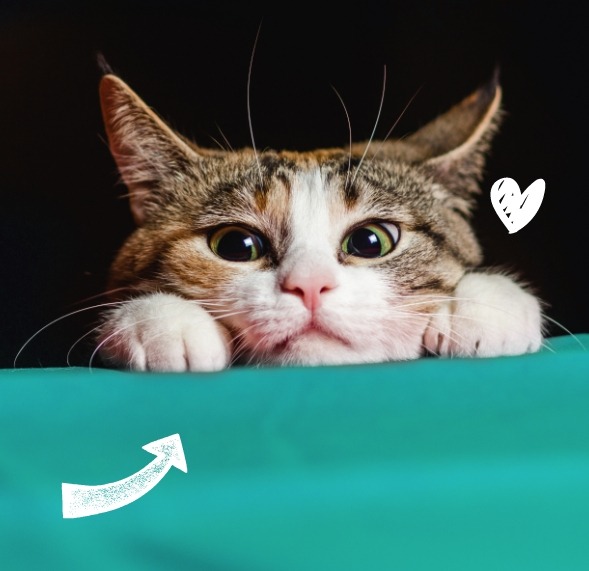
Whether you’re a first time cat owner or you’ve had a long time feline friend, you’ve will have found yourself wishing you knew what your cat was thinking. Feline body language is very subtle. Knowing which behaviours are normal is the key to recognising behavioural problems or changes in your cat.
Understanding your cat’s behaviour can help you better meet their needs. It can also help you develop a happy and healthy relationship with your pet. This handy guide looks at feline body language and vocalisations to help you identify normal and abnormal behaviour in cats.
Normal cat behaviour
Cats learn normal social behaviour by observing and imitating their mother and litter. This starts when they are around two to three weeks old. When they interact with other cats at this age, they learn how to restrict their bite and retract their claws during normal play. Kittens who are removed from their litter before ten weeks of age may have trouble learning how to safely interact with other pets and humans.
For cats, play is a major part of developing proper social skills. Different types of play behaviour include attack and defence stances, chasing, pouncing and vocalisations. Vocalisations vary in cats, from hissing and spitting to soft purring and meowing. Softer sounds tend to indicate friendliness or contentment. Sounds like yowling and crying can be a sign of anger, heat, distress, anxiety or pain.
Grooming is another behaviour which is normal for cats. They typically spend up to 30% of their waking time keeping their fur in good condition. It’s important to watch out for signs of abnormal grooming in your cat. This includes overlicking, excessive scratching and matted fur. These signs can also indicate a skin condition or irritation. Other signs of abnormal behaviour in cats include excessive hiding, sleeping in a hunched position, excessive aggression and irregular eating.
Happy cat behaviour
Like us, cats express how they feel through body language as well as vocalisations. While every cat is different, the telltale signs of a happy cat include meowing, deep purring, well-groomed fur, a relaxed posture and playful behaviour. Cats can be very vocal creatures and the pitch of their meow is one of the best indicators of how they’re feeling. High-pitched meowing means contentment, while a low-pitched meow may indicate an unhappy cat.
While dogs wag their tails to show their happiness, cats purr. While purring does not automatically mean your cat is completely happy, it can be a sign of contentment, relaxation and comfort. Cats have different types of purr that they may use when they want our attention or when they’re hungry, as well as when they’re stressed or sick.
A healthy appetite is a great sign of a happy pet. Your cat may ask you for food by rubbing around your legs and meowing, as well as hitting their bowl. If your cat allows you to give them a treat when they’re relaxed or sleepy, this is a sign of trust. To treat your feline friend, try our Tasty Sticks Mini Mix Cat Treats.
Affectionate cat behaviour
It’s often said that dogs are more affectionate than cats, but that’s just because dogs have more explicit ways to show affection. One of the subtle ways your cat will show affection is by wandering around your home. Cats are more likely to explore their environment when they feel safe and comfortable in a person’s presence. So, your cat walking away from you is actually a compliment.
You can also tell a lot from the way a cat holds their tail. When showing affection, your cat may wind their way through your legs. They may also sit close enough to you that their tail just touches your leg. If your cat purrs while you stroke them, they are vocally letting you know how much they are enjoying their bonding time. If a cat feels comfortable enough to offer you their stomach for a rub, this is the ultimate sign of trust and affection.
Sometimes it may seem like your cat is starting to get aggressive by pawing and biting while you play. They’re actually just trying to show affection. Unless they’re fighting or hunting, a cat’s bite and scratches shouldn’t break the skin. If your cat does end up biting you too hard, you should stop engaging in any behaviour that may be upsetting them and leave them to calm down.
Anxious cat behaviour
Cats rarely show the same signs of anxiety and owners often attribute their cat’s change in behaviour to something else. If your cat tends to hide on a regular basis, it can be easy to not notice that their anxiety levels have increased. Some signs of anxiety may include: a loss of appetite, excessive grooming, sleeping more, reduced interaction with family members, hiding and aggression.
An anxious cat may sit in a tense and crouched position, with their tail tucked in. If your cat is trying to get your attention with excessive meowing and you’re not sure what they want, they may be trying to tell you that they’re anxious or afraid. Distressed cats will often stop using their litter box and may toilet elsewhere in the house to try and get your attention.
When cats are feeling stressed or unwell, they may suffer from a lack of appetite. When your cat stops eating, it’s important to identify and eliminate the cause of their stress as soon as possible to get their feeding routine back on track. To try convince your cat to eat, heat up their favourite cat food to enhance the smell and make sure their dishes or bowls are clean.
Hostile cat behaviour
There are many reasons why cats may show aggressive behaviour, including anxiety, anger, hunting, defending territory or playfulness. Some of the warning signs that indicate a cat is hostile include: a twitching tail, flattened ears, restlessness, quick reactions to movement and dilated pupils.
If your cat is tensely lying down with a flattened body and ears, they’re telling you that they’re not happy and that they want you to stay away. When a cat is angry, they will stand up tall with an arched back and raised hair, and may hiss at you when you try to approach them. Some cats may exhibit these signs if they feel cornered or provoked.
Threats and aggression can be either offensive or defensive. An offensively aggressive cat may try to make themselves look bigger and more intimidating, whereas a defensively aggressive cat will adopt a hunched or curled posture to make themselves look smaller. Regardless, it’s best not to touch or attempt to reassure a hostile cat.
The Webbox difference
We pride ourselves on seeing the world from a cat’s point of view, so we can understand what they want – not just what they need. We put our love, creativity and fun into everything we make, offering delicious food and enticing treats designed to keep your cat happy and healthy. For fantastic food and tempting treats, shop our cat food range today.

Shop for Dogs
Personalise your search:
Shop for Cats
Personalise your search:
Our Most Popular Products

Webbox Lick-e-Lix with Beef Cat Treats

Webbox Lick-e-Lix Liver Sausage & Cat Grass Cat Treats

Webbox Lick-e-Lix Chicken Cat Treats

Webbox Lick-e-Lix Cheese & Taurine Cat Treats

Webbox Naturals Fish & Meat in Jelly Wet Cat Food

Squeaky Ball

Webbox Naturals Tuna Mousse Wet Cat Food

Webbox Naturals Adult Cat with Chicken and Salmon Dry Food

Webbox Naturals Dry Adult Cat with Chicken and Duck Dry Food
Get the latest tips ‘n’ advice
Want to find out interesting facts and get helpful tips?
Need help choosing the right food?
Try our Pet Food Finder.








